
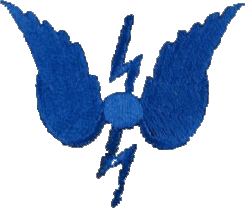

The following three articles on the Rhine Squadron come courtesy of the Globe and Laurel magazine the official journal of the Royal Marines
Royal Navy Rhine Squadron
Autumn Cruise 1956
Courtesy of the Globe and Laurel magazine
© Globe & Laurel official journal of the Royal Marines
I wonder what picture is conjured up in your mind when the River Rhine is mentioned? Perhaps you see the steep cliffs and fantastic castles, the rocks and their complement of Rhine-maidens - the Rhine of Wagner; perhaps the pillboxes and fortresses growling at each other across the river of commerce, with its long barge trains and factory studded banks. All these pictures came to life for us when the Squadron sailed up to Strasbourg for the Autumn Cruise.
After sailing past the Captain embarked in Prince Charles each division went its separate way to the various towns up the length of the river, finally converging on the U.S. Naval Base at Karlsruhe. It is impossible in the space allowed to trace the separate ways and to relate the separate fortunes of the divisions, so I will attempt to create a word picture for you of the river as we saw it on our way to that historic city.
Krefeld is on the southern fringe of the Ruhr, and so we are well endowed with factories. These, however, soon die out, giving way to green banks, built high to protect the low-lying fields from flood water. This scenery is only interrupted twice, at Dusseldorf and Cologne, before the Federal Capital at Bonn is reached. Of these three cities, the second is perhaps the most interesting. The Cathedral, with its twin spires of beautifully worked blackened stone, is world famous.
After Bonn the hills begin, and on the left you can see "The Seven Hills" culminating in the famous Drachenfels, surmounted by a gaunt, ruined tower. These hills are only an overture, however, and several more kilometres of flat country follow before the hills close in again at Koblenz. Now the river runs deep and fast, the frowning hills plunge steeply down, scoured here and there by terraced vineyards. On every commanding pinnacle a castle stands, some well preserved, some in ruins, but all with a tale to tell. Past the domed turret of the Pfalz, the castle on an island, past the Lorelei, where the river swirls round a narrow S bend, past the hazardous, rocky Binger Loch we steam, and quite suddenly we are in flat country again.
Soon we pass the old city of Mainz, sadly wasted by the violence of war, the entrance to the River Main, past Worms and Mannheim, where the River Neckar, on which Heidelberg stands, joins the Rhine. On then we go to Karlsruhe and the point where the French frontier comes down to the river. The Rhine runs fast and straight, though deceptively so, for the narrow channel winds from side to side. Each bank is thickly wooded and the pillboxes of "The Watch on the Rhine" can still be seen although all have been demilitarised, their great concrete walls torn apart by explosives.
Strasbourg itself is a very old city, steeped in history. Within the lifetime of some of its inhabitants, it has changed hands three times; consequently a strange form of German patois is spoken, quite incomprehensible, even to our linguists.
A very full programme of entertainment was prepared for us by the French Navy based on Kehl, on the German side of the river. The hospitality started immediately, though somewhat unofficially, when a surprised French liaison officer, jumping ashore from Prince Charles had a large bouquet of flowers thrust in his hands by a jovial, but unsteady, Strasbourgois, who had mistaken him for the Captain.
Two bus tours to the Vosges mountains were voted the highlights of the stay, though liquid refreshment was also available, we understand, for those who attended the premiere of "Cockleshell Heroes", a film which went down very well with the large audience. Berthed as we were alongside a public road, we were undoubtedly one of the weekend sights of Strasbourg. There was always a large audience from dawn to dusk, the children especially finding us a curiosity not to be missed. The fluent way some of the ship's company were conversing with them, one is led to wonder if, perhaps, there is a certain similarity between our school French and the Alsatian patois!
In the sporting line, we once again played the Racing Club d'Alsace, a semi-professional team who, it is sad to say, proved far too strong for us. The score was 9-0. We're improving though - last year it was 13-1!
Two officers were invited to broadcast over the local network. Considering that one of them said he couldn't speak French anyway, I understand they acquitted themselves very well and so our visit to Strasbourg ended in blazing sunshine.
- - - - - - - - - - - - - - - - - - - - - - - - - - - -
Royal Navy Rhine Squadron
Spring Cruise 1957
Courtesy of the Globe and Laurel magazine
© Globe & Laurel official journal of the Royal Marines
“I must go up the Rhine again, to K.M. 755,
And all I ask is an H.Q. Ship and a tug to tow her by;
And rudders lost and tow wires parted and the SOO will con,
And an S.P. barge on the port bow and all the brandy gone.”
“RIVER FEVER.”
Our yearly pilgrimage to the sea started one blustery April morning, when the M.L.s and the Headquarter ship Prince Charles, started out from Rheinhafen. Our route, however, this year wound tortuously through Holland and Belgium by the many canals and waterways, which dissect those two countries. Indeed, the first and Second days found us doubling back up the River Maas, which took us along the narrow neck of Holland, between Belgium and Germany, which is the province of Lemburg. We passed the gay town of Maastricht somewhat regretfully, as the sirens on the banks' seemed anxious to bid us welcome, and crossed the frontier into Belgium by one of the narrowest canals I have ever seen. Here, a lock, like an open grave, whisked us up 70 feet to the splendour of the historic Albert Canal. The first part of this canal is cut through a hill, so that sheer sandstone cliffs rose hundreds of feet on either side. One trembled to think what Bickleigh could have made of it!
The Albert Canal led us, straight as an arrow, to the great port of Antwerp. In this cosmopolitan city, where we spent two days, we were joined by the two L.C.T.S, which had started several days later and had taken the more conventional route by the River Waal and the Scheldt Estuary.
A start with “the grey dawn breaking” brought us to the Belgian capital city, where, rather to our disappointment, we berthed at a place not unlike the Coaling Jetty at Devonport. It was, however, an easy train ride to the centre of the town, and anyway we were right royally entertained. Our entry into Brussels was filmed, and we appeared on television that evening.
There was much to see in Brussels' and the tours organised for us were very popular. Apart from the many interesting and lovely buildings in the city itself, there was a chance to see a place very dear to British hearts, the Field of Waterloo. It tickled one officer’s fancy that he could go to the booking office at the Central Station in Brussels, which is, incidentally, underground, and ask for a ticket to Waterloo. His French, however, was insufficient to get him on the right train, and he went off in completely the wrong direction.
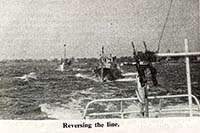
The L.C.T.s left us in Brussels, and headed towards the sea again, where one commanded by a Royal Marine, needless to say, lost both rudders, and then wondered why it was difficult to steer! The M.Ls. moved off toward Ghent, wishing our ships weren’t quite so tall. The low bridges helped some of us to remember we hadn’t taken down one or other of the protrusions on top of the wheelhouse. An expensive noise here and there at least gave us the consolation that we wouldn’t have to bother taking the thing down again.
Ghent is a lovely city, steeped in history. Its medieval buildings are beautifully preserved and wonderfully presented for the public view. The officers of the Squadron were privileged to be received by the Burgomaster in the magnificent city hall. It was a most impressive ceremony, held in the old chapel of the city council, with an enormous stained glass window as a backcloth.

"ICKFORD" berthing at HAARLEM., ahead of "HMS DARK HERO" and "BOLD PATHFINDER".
Our next stop was at Bruges, where we berthed at the Naval Base. The writer had little chance to see this lovely town, but I understand the wealth of architecture equalled, if not surpassed Ghent’s. Unfortunately, as the weather boded foul, our glimpse of the sea was only a fleeting one. Passing through the Dutch islands, we set course for home. It was a long pull up the Waal and into the Rhine, and we spent two nights at the staging points, Tiel in Holland, and Wesel in Germany. Flag Officer, Germany, embarked in Prince Charles on the last day, and sailed past the Squadron, our sides battered by the many locks we had passed through, and yet unbowed.
- - - - - - - - - - - - - - - - - - - - - - - - - - - -
Royal Navy Rhine Squadron
Autumn Cruise 1957
Courtesy of the Globe and Laurel magazine
© Globe & Laurel official journal of the Royal Marines
Between the 18th and 19th August, the Squadron departed for the Autumn Cruise. As has become customary, it covered the upper reaches of the River Rhine. This year, instead of proceeding as a whole, each Division and Sub-Division sailed to arrive at predetermined rendezvous. The main result of this being, that no sooner had one German town breathed a sigh of relief to see four boats disappear into the morning mist, than a fresh lot would appear in the afternoon haze. Truthfully, however, it must be said that one of the features of the cruise was the goodwill and kindness shown by everyone in all the places we visited.
To those who have enjoyed a trip up the Rhine, or to those who have heard of its beauties, a short geographical resume may serve as a reminder. Leaving Krefeld, we passed through Dusseldorf, Koln, Bonn, Koblenz and St. Goar. Amongst these St. Goar boasts the famous “Lorelei”, on whose summit, it is said, a beautiful maiden combed her hair and sang with a voice of such sweetness, as to cause mariners to stare in a trance forgetting the dangers at this point of the river, until they were swept on the treacherous rocks. So on to the Binger Lock, where the only craft that do not take pilots are the barges with skippers averaging about 20 years’ experience on the river and the Royal Naval Rhine Squadron with an equal amount of pride. Bingen and Rudesheim, the latter a popular holiday resort, are really the centre of the Rhine wine country, and although we were a little too early for the Wine Festival, the folly of mixing wine and German beer was soon discovered. On to Mainz, where the Minor Landing Craft Division branched off on its ‘own up the River Main, where it was greeted with considerable surprise, one German asking its senior officer if they were a visiting American band. With considerable ingenuity the Petty Officer M(E) of the M.L.6050 had rigged a shower in the engine room. This was in much demand, even in the murky waters of the Rhine, but the coffee coloured effects of the Main were enough to defeat even the most fervent student of cleanliness. Alas! Discretion was the better part of squalor. They proceeded through Hanan into Bavaria and thence back to Frankfurt. The author has had some difficulty in discovering quite what they did, but gathers they enjoyed themselves.
Meanwhile the M.L. Division carried on up to Mannheim and there into the River Neckar. To get a hundred kilometres upstream, it was necessary to negotiate 12 locks, during which the soapy deposit in the water was such as to cause bubbles to rise to an extent where it became necessary to assume damage control state one, to avoid having one’s carpets washed.
It was the first time the Squadron had been up the Neckar, and the interest shown was a trifle unnerving. This was especially true at Heidelberg, Headquarters of the United States Army, Europe, where “Prince Charles” and the 8 ML’s joined for the first time. From Colours in the morning until 9 at night there was always a large crowd leaning over the railings in a ceaseless vigil. This can best be illustrated by the incident of the unfortunate officer changing to go ashore in the evening, who had his wardroom curtains pulled aside by a walking stick and heard a child’s voice exclaim: “Gee, Dad, he’s changing his underwear”. A greater attraction, however, was undoubtedly the Guard of Honour, paraded for the Burgomaster, who during a period of half an hour had their photographs taken over 200 times.
During the last phase of the cruise we visited our Allied Squadrons on the Rhine and in three successive nights we called on the Americans at Schierstein, the French at Koblenz and the Belgians at Niehl. The fun was fast and furious and it was a very tired but contented Squadron that turned into Rheinhafen on the 5th September, 1957.
A memorable cruise—in spite of the weather.
In the sporting line, we once again played the Racing Club d'Alsace, a semi-professional team who, it is sad to say, proved far too strong for us. The score was 9-0. We're improving though - last year it was 13-1!
Two officers were invited to broadcast over the local network. Considering that one of them said he couldn't speak French anyway, I understand they acquitted themselves very well and so our visit to Strasbourg ended in blazing sunshine.
- - - - - - - - - - - - - - - - - - - - - - - - - - - -
Royal Navy Rhine Squadron
Spring Cruise 1957
Courtesy of the Globe and Laurel magazine
© Globe & Laurel official journal of the Royal Marines
“I must go up the Rhine again, to K.M. 755,
And all I ask is an H.Q. Ship and a tug to tow her by;
And rudders lost and tow wires parted and the SOO will con,
And an S.P. barge on the port bow and all the brandy gone.”
“RIVER FEVER.”
Our yearly pilgrimage to the sea started one blustery April morning, when the M.L.s and the Headquarter ship Prince Charles, started out from Rheinhafen. Our route, however, this year wound tortuously through Holland and Belgium by the many canals and waterways, which dissect those two countries. Indeed, the first and Second days found us doubling back up the River Maas, which took us along the narrow neck of Holland, between Belgium and Germany, which is the province of Lemburg. We passed the gay town of Maastricht somewhat regretfully, as the sirens on the banks' seemed anxious to bid us welcome, and crossed the frontier into Belgium by one of the narrowest canals I have ever seen. Here, a lock, like an open grave, whisked us up 70 feet to the splendour of the historic Albert Canal. The first part of this canal is cut through a hill, so that sheer sandstone cliffs rose hundreds of feet on either side. One trembled to think what Bickleigh could have made of it!
The Albert Canal led us, straight as an arrow, to the great port of Antwerp. In this cosmopolitan city, where we spent two days, we were joined by the two L.C.T.S, which had started several days later and had taken the more conventional route by the River Waal and the Scheldt Estuary.
A start with “the grey dawn breaking” brought us to the Belgian capital city, where, rather to our disappointment, we berthed at a place not unlike the Coaling Jetty at Devonport. It was, however, an easy train ride to the centre of the town, and anyway we were right royally entertained. Our entry into Brussels was filmed, and we appeared on television that evening.
There was much to see in Brussels' and the tours organised for us were very popular. Apart from the many interesting and lovely buildings in the city itself, there was a chance to see a place very dear to British hearts, the Field of Waterloo. It tickled one officer’s fancy that he could go to the booking office at the Central Station in Brussels, which is, incidentally, underground, and ask for a ticket to Waterloo. His French, however, was insufficient to get him on the right train, and he went off in completely the wrong direction.

The L.C.T.s left us in Brussels, and headed towards the sea again, where one commanded by a Royal Marine, needless to say, lost both rudders, and then wondered why it was difficult to steer! The M.Ls. moved off toward Ghent, wishing our ships weren’t quite so tall. The low bridges helped some of us to remember we hadn’t taken down one or other of the protrusions on top of the wheelhouse. An expensive noise here and there at least gave us the consolation that we wouldn’t have to bother taking the thing down again.
Ghent is a lovely city, steeped in history. Its medieval buildings are beautifully preserved and wonderfully presented for the public view. The officers of the Squadron were privileged to be received by the Burgomaster in the magnificent city hall. It was a most impressive ceremony, held in the old chapel of the city council, with an enormous stained glass window as a backcloth.
"ICKFORD" berthing at HAARLEM., ahead of "HMS DARK HERO" and "BOLD PATHFINDER".
Our next stop was at Bruges, where we berthed at the Naval Base. The writer had little chance to see this lovely town, but I understand the wealth of architecture equalled, if not surpassed Ghent’s. Unfortunately, as the weather boded foul, our glimpse of the sea was only a fleeting one. Passing through the Dutch islands, we set course for home. It was a long pull up the Waal and into the Rhine, and we spent two nights at the staging points, Tiel in Holland, and Wesel in Germany. Flag Officer, Germany, embarked in Prince Charles on the last day, and sailed past the Squadron, our sides battered by the many locks we had passed through, and yet unbowed.
- - - - - - - - - - - - - - - - - - - - - - - - - - - -
Royal Navy Rhine Squadron
Autumn Cruise 1957
Courtesy of the Globe and Laurel magazine
© Globe & Laurel official journal of the Royal Marines
Between the 18th and 19th August, the Squadron departed for the Autumn Cruise. As has become customary, it covered the upper reaches of the River Rhine. This year, instead of proceeding as a whole, each Division and Sub-Division sailed to arrive at predetermined rendezvous. The main result of this being, that no sooner had one German town breathed a sigh of relief to see four boats disappear into the morning mist, than a fresh lot would appear in the afternoon haze. Truthfully, however, it must be said that one of the features of the cruise was the goodwill and kindness shown by everyone in all the places we visited.
To those who have enjoyed a trip up the Rhine, or to those who have heard of its beauties, a short geographical resume may serve as a reminder. Leaving Krefeld, we passed through Dusseldorf, Koln, Bonn, Koblenz and St. Goar. Amongst these St. Goar boasts the famous “Lorelei”, on whose summit, it is said, a beautiful maiden combed her hair and sang with a voice of such sweetness, as to cause mariners to stare in a trance forgetting the dangers at this point of the river, until they were swept on the treacherous rocks. So on to the Binger Lock, where the only craft that do not take pilots are the barges with skippers averaging about 20 years’ experience on the river and the Royal Naval Rhine Squadron with an equal amount of pride. Bingen and Rudesheim, the latter a popular holiday resort, are really the centre of the Rhine wine country, and although we were a little too early for the Wine Festival, the folly of mixing wine and German beer was soon discovered. On to Mainz, where the Minor Landing Craft Division branched off on its ‘own up the River Main, where it was greeted with considerable surprise, one German asking its senior officer if they were a visiting American band. With considerable ingenuity the Petty Officer M(E) of the M.L.6050 had rigged a shower in the engine room. This was in much demand, even in the murky waters of the Rhine, but the coffee coloured effects of the Main were enough to defeat even the most fervent student of cleanliness. Alas! Discretion was the better part of squalor. They proceeded through Hanan into Bavaria and thence back to Frankfurt. The author has had some difficulty in discovering quite what they did, but gathers they enjoyed themselves.
Meanwhile the M.L. Division carried on up to Mannheim and there into the River Neckar. To get a hundred kilometres upstream, it was necessary to negotiate 12 locks, during which the soapy deposit in the water was such as to cause bubbles to rise to an extent where it became necessary to assume damage control state one, to avoid having one’s carpets washed.
It was the first time the Squadron had been up the Neckar, and the interest shown was a trifle unnerving. This was especially true at Heidelberg, Headquarters of the United States Army, Europe, where “Prince Charles” and the 8 ML’s joined for the first time. From Colours in the morning until 9 at night there was always a large crowd leaning over the railings in a ceaseless vigil. This can best be illustrated by the incident of the unfortunate officer changing to go ashore in the evening, who had his wardroom curtains pulled aside by a walking stick and heard a child’s voice exclaim: “Gee, Dad, he’s changing his underwear”. A greater attraction, however, was undoubtedly the Guard of Honour, paraded for the Burgomaster, who during a period of half an hour had their photographs taken over 200 times. During the last phase of the cruise we visited our Allied Squadrons on the Rhine and in three successive nights we called on the Americans at Schierstein, the French at Koblenz and the Belgians at Niehl. The fun was fast and furious and it was a very tired but contented Squadron that turned into Rheinhafen on the 5th September, 1957.
A memorable cruise—in spite of the weather.
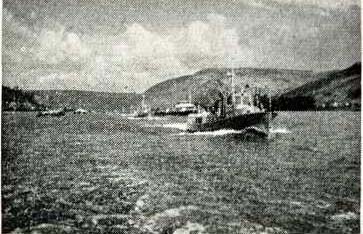 Rhine Squadron - MLs On Passage Rhine Squadron - MLs On Passage |
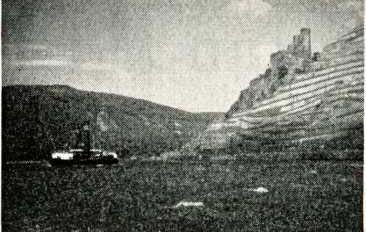 A Rhine hazard in picturesque surroundings A Rhine hazard in picturesque surroundings |
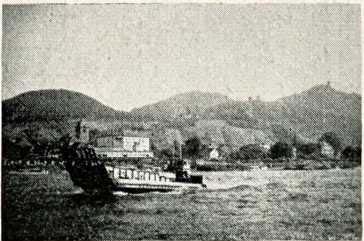 LCM Passing Ramagen LCM Passing Ramagen |